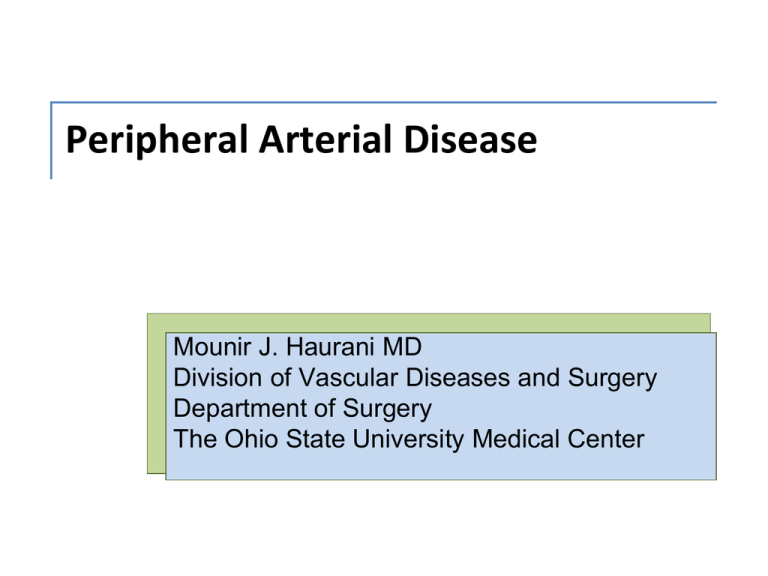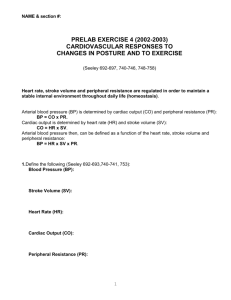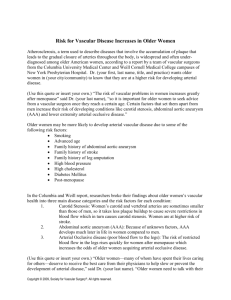
Peripheral Arterial Disease
Mounir J. Haurani MD
Division of Vascular Diseases and Surgery
Department of Surgery
The Ohio State University Medical Center
Disclosures
Research Agreements with Bolton Medical and Grifols
Pharmaceuticals, payments made to OSU
Objectives
Relate the
pathophysiology of
atherosclerosis
Peripheral Vascular
Disease
Aortic
Carotid Artery
Surgical management
associated with the
sequelae
Atherosclerosis
Most common cause of peripheral arterial occlusive
disease
Preferentially involves the internal carotid, infrarenal
aorta, and superficial femoral arteries
Typically occurs at bifurcations
Pathology
Lipid Hypothesis
Response-to-Injury Hypothesis
Monoclonal Hypothesis
Lipid Hypothesis
Cholesterol first isolated from gallstones in 1784
Nikolai Anitschkow produced vascular lesions in
rabbits by feeding them purified cholesterol
Lipid Hypothesis
Earliest lesions consisted of foam cells that were Sudan
positive and contained birefringent crystals
Distinctive pattern consisting of location of the lesions
near arterial branch points
Lipid Hypothesis
Epidemiologic evidence (Framingham Heart Study)
association between cholesterol and incident CHD.
Trials demonstrated that reducing cholesterol reduces
cardiovascular events
Response To Injury
Basis lies in the similarities between atherosclerosis and
the response of arteries to experimental injury.
Injury to the endothelium is a seminal event
Stimulating the cascade of events leading to lesion
formation.
Response To Injury
Adhesion of platelets and an influx of LDL
Platelets stimulate migration of SMCs into the intima
Neointima responsible for narrowing of the arterial
lumen.
Experimental Model of Response to Injury Hypothesis
Copyright © American Heart Association, Inc. All rights reserved.
Jacobson G M et al. Circulation Research. 2003;92:637-643
Monoclonal Hypothesis
Each lesion of atherosclerosis is derived from a single
SMC
Atherosclerotic plaque from four females and compared
them with adjacent normal areas of arterial wall.
SMCs from the plaque contained only one G6PD isoform
whereas adjacent control areas contained a mixture of
isoforms.
Progression of Atherosclerosis
Rutherford’s Vascular Surgery 7th Edition, Chapter 4 Atherosclerosis
Plaque Complications
Necrotic core of lipid, macrophages, and smooth
muscle cells
Calcification
Endothelial disruption
Ulceration
Hemorrhage
Embolism
Pathophysiology
Atherosclerosis may cause symptoms via:
stenosis or occlusion
thromboembolism
cardiogenic
arterioarterial
thrombosis of complicated plaque
Inadequate tissue perfusion
Infrainguinal Arterial Occlusive Disease
Affects 17% of people over 70
Asymptomatic
Claudication
Rest Pain /
Tissue Loss
Rutherford’s Vascular Surgery 7th Edition, Chapter 4 Atherosclerosis
Claudication
Pain in the large muscle groups distal to an
arterial lesion after exercise
Cramping, heaviness, fatigue
Occurs consistently after a certain distance of
walking
Reliably abates when patient stops
The patient is asymptomatic at rest because
there are adequate collaterals for perfusion
without increased metabolic demand
Claudication
CAD
5 Yr
Mortality
• 90%
• 5%
amputation
• 23% MI
• 13%
Stroke
• 5 yr = 20%
• 10 yr
=50%
• 15yr =
70%
Treatment of Claudication
Risk factor modification
smoking cessation
hypertension
hyperlipidemia
diabetes
Cilostazol
rheologic agent
increases walking distance
contraindicated in CHF
Supervised exercise program
30 minutes of cardiovascular exercise daily
5 days per week
Treatment of Claudication
Procedural intervention for claudication is reserved for
patients with lifestyle-limiting claudication and failure of
medical therapy
Often, this is related to single level, proximal disease
aortoiliac
femoral
ABI 0.6
Critical Limb Ischemia
Ischemic rest pain
intense pain across distal foot and arch
burning, stabbing, constant
worsened with elevation
dependent rubor
Ulceration
Gangrene
dry
wet
Outcomes of CLI
Treatment of Rest Pain or Tissue Loss
Risk factor modification
Restoration of in-line vascular flow
Management of the wound
Often, this is related to multi level or distal disease
popliteal
tibial
ABI 0.3
Ankle Brachial Index
• Claudication
• Rest pain
• Tissue loss
0.6
0.3
0.2
Aboyans V et al. Circulation. 2012;126:2890-2909
Copyright © American Heart Association, Inc. All rights reserved.
Percutaneous Treatment Results Are
Better…
Proximal vessels (aorta > iliacs > SFA > tibials)
Short lesions
Focal lesions
Stenoses > occlusions
Percutaneous Treatments Are
Worse…
Distal or smaller vessels
Long lesions
Diffuse lesions
Occlusions
At joints or bifurcations
common femoral
profunda
popliteal
Surgical Options
Endarterectomy
Bypass
normal inflow
normal outflow
Levels of Disease
Aortoiliac
aortoiliac endarterectomy
aortofemoral bypass
axillary femoral bypass
Femoropopliteal
femoral endarterectomy
femoropopliteal bypass
Tibial
femorotibial bypass
popliteal tibial or pedal bypass
Aortobifemoral
Bypass
In-situ Thrombosis
Thrombosis of a chronically diseased vessel
Rutherford’s Vascular Surgery 7th Edition, Chapter 4 Atherosclerosis
Acute Limb Ischemia
Pain
Pallor
Paresthesia
Paralysis
Pulseless
Poikilothermia
Aneurysm
AAA Demographics
200,000 patients diagnosed with non-ruptured AAA each
year
1.5 to 2 million are estimated to have an undiagnosed
AAA
50% of patients with untreated aneurysms > 5.5 cm will
die of rupture within five years
15,000 deaths each year
Risk of Rupture
Mortality = 35 - 75%
unchanged over past
4 decades
higher with COPD,
multiple comorbidities
J Vasc Surg 2003; 37: 1106-17
Diameter
Annual Risk
of Rupture
< 4 cm
0%
4 - 5 cm
0.5 - 5 %
5 - 6 cm
3 - 15 %
6 - 7 cm
10 - 20 %
7 - 8 cm
20 - 40 %
> 8 cm
30 - 50 %
Rupture
Approximately 40% of patients with ruptured AAAs die
prior to presentation to the emergency department
Only 10% to 25% of individuals with ruptured AAA
survive until hospital discharge
Prevent rupture!
Treatment Options
Watch and wait
AAA < 5cm, asymptomatic
surgical risks > risk of rupture
lifestyle changes cannot reduce the size of the AAA
Open surgical repair
Endovascular repair
Open Versus Endovascular Repair
No difference in overall mortality
Advantage in aneurysm related mortality for EVAR
Increased complication and reintervention rate for EVAR
Stroke
600,000 strokes per year in U.S.
150,000 death from stroke per year
3rd leading cause of death
Stroke
Thromboembolic (85%)
cardiac embolization
extracranial carotid embolization
intracranial atherosclerosis
Hemorrhagic (15%)
Symptoms
Amaurosis
Hollenhorst plaques (cholesterol emboli)
TIA
abrupt onset
usually lasts 15 minutes or less but up to 24 hours is included in
definition
up to 15% risk of stroke within 3 days
Stroke
> 24 hours
Symptoms
Motor or sensory deficit contralateral to affected carotid
artery
Amaurosis ipsilateral to affected carotid artery
Treatment
Warfarin – stroke from cardiac embolization
Aspirin – indicated for all patients with atherosclerotic
disease
There is no evidence supporting the use of Plavix or
heparin / warfarin to prevent or treat stroke related to
extracranial carotid disease
Carotid Revascularization
Symptomatic (NASCET)
> 50% stenosis
reduces two year stroke risk from 26% to 9%
Asymptomatic (ACAS)
>60% stenosis
reduces five year stroke risk from 11% to 6%
Endarterectomy
Appropriate for most patients
Lower periprocedural stroke risk
Higher risk for cardiac complications
What do you
see?
Stenting
Higher periprocedural stroke risk
Lower cardiac morbidity
Consider in:
NYHA III or IV CHF
EF < 30%
unstable angina
recent MI
contralateral occlusion
recurrent stenosis
radiation
COPD
anatomically inaccesible lesion
cervical immobility
prior neck dissection
tracheostomy
contralateral cranial nerve injury
What do you see
Summary
Atherosclerosis involves many vascular beds
concurrently
It can present with a spectrum of symptoms
Treatment is reduction of risk factors with procedural
intervention reserved for failure of medical management
Several acute manifestations can arise that require
emergent treatment
Thank you
Thank you for completing this module.
If you have any questions or feedback, please contact me:
Mounir.Haurani@osumc.edu
Survey
We would appreciate your feedback on this module. Click on the
button below to complete a brief survey. Your responses and
comments will be shared with the module’s author, the LSI
EdTech team, and LSI curriculum leaders. We will use your
feedback to improve future versions of the module.
The survey is both optional and anonymous and should take
less than 5 minutes to complete.
Survey







